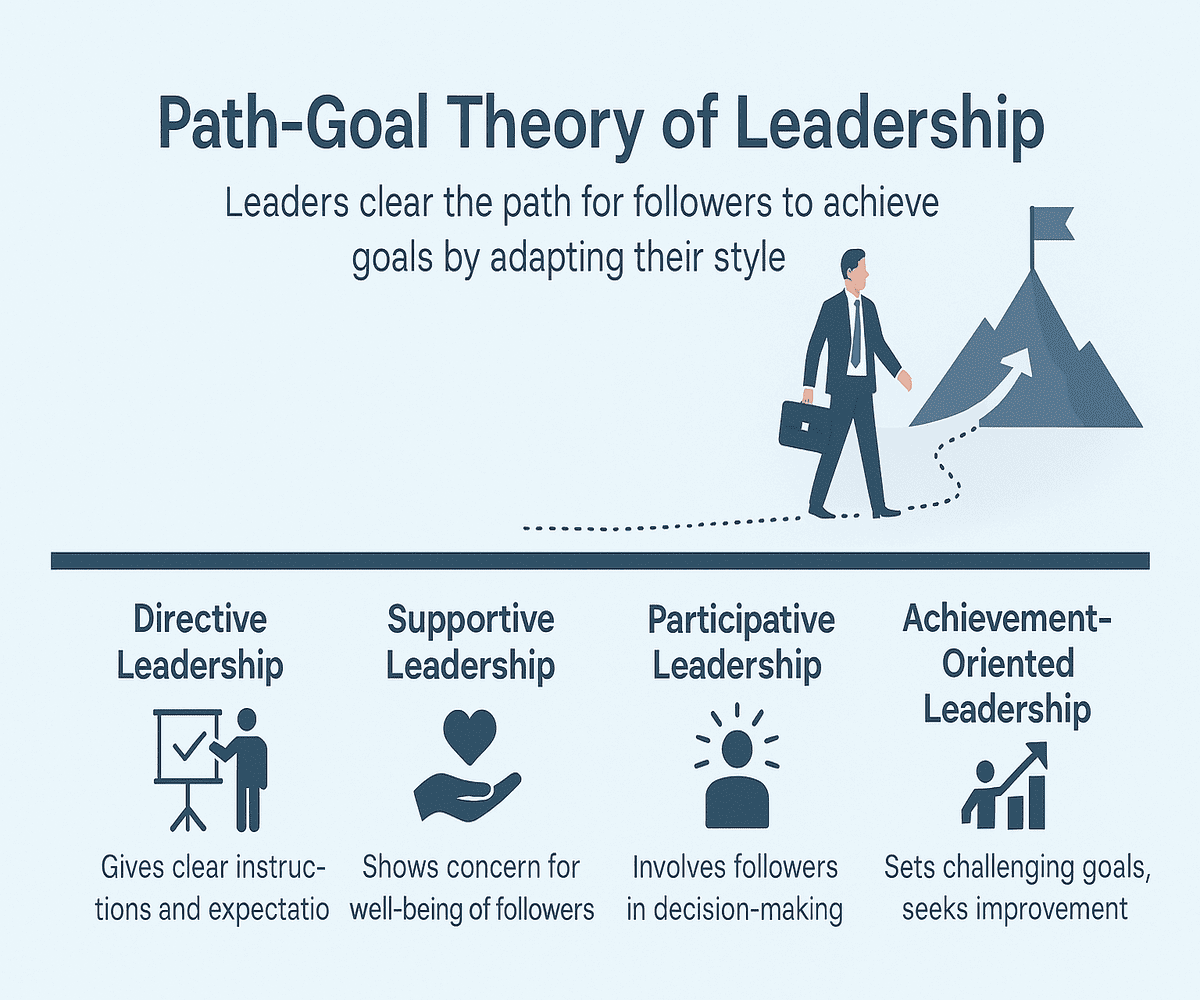Path-Goal Theory of Leadership: A Clear Roadmap to Team Success
Introduction: What Is Path-Goal Theory and Why Does It Matter?
In a constantly evolving work environment, leaders must do more than delegate—they must guide, support, and adapt. That’s the central idea behind the Path-Goal Theory, developed by Robert House in 1971. This theory proposes that the leader’s job is to help team members achieve their goals by clearing obstacles and adapting their style to the team’s characteristics and the nature of the task.
Unlike rigid leadership models, Path-Goal Theory empowers leaders to shift their approach depending on employee needs, task complexity, and the work environment.
Core Premise: Leaders Facilitate Success
The theory is rooted in Expectancy Theory of motivation, which suggests that employees are motivated when they believe:
-
Their effort will lead to performance,
-
That performance will lead to rewards,
-
And the rewards are meaningful to them.
Path-Goal leadership thus focuses on increasing employee motivation by aligning leadership behaviors with these three beliefs. Leaders help by “clearing the path” toward goal attainment—removing barriers, clarifying tasks, and offering the right support.
The Four Leadership Styles in Path-Goal Theory
Robert House identified four leadership styles that leaders can adopt depending on the needs of their team and the nature of the work. Each style is designed to enhance employee satisfaction, effort, and performance.
1. Directive Leadership
Definition: The leader provides clear guidelines, instructions, and timelines.
When to Use:
-
When tasks are complex, unclear, or unstructured
-
When employees are new, uncertain, or inexperienced
How It Helps:
-
Reduces ambiguity by outlining who does what and when
-
Builds structure and confidence in employees
-
Improves efficiency in high-pressure environments
Example: A project manager assigns tasks with specific instructions and deadlines to a newly formed team handling a critical software rollout.
2. Supportive Leadership
Definition: The leader shows concern for employee welfare and creates a friendly work environment.
When to Use:
-
When the work is stressful, repetitive, or tedious
-
When team morale is low or team members are disengaged
How It Helps:
-
Creates a psychologically safe environment
-
Enhances employee well-being and loyalty
-
Encourages team bonding and trust
Example: A team lead offers emotional support and flexible scheduling for a customer service team working night shifts.
3. Participative Leadership
Definition: The leader encourages employees to contribute to decision-making and problem-solving.
When to Use:
-
When employees are experienced and capable
-
When tasks require collaboration or innovation
How It Helps:
-
Increases ownership and engagement
-
Leverages collective intelligence
-
Improves team satisfaction and innovation
Example: A marketing manager asks the team for input on campaign strategies and considers their feedback before finalizing decisions.
4. Achievement-Oriented Leadership
Definition: The leader sets challenging goals and expects high performance, showing confidence in the team’s abilities.
When to Use:
-
When team members are skilled, self-motivated, and ambitious
-
When the job requires precision and problem-solving
How It Helps:
-
Encourages a high-performance culture
-
Inspires continuous growth and self-improvement
-
Builds a sense of pride and competition
Example: A team lead challenges a group of senior analysts to deliver a new product forecast model ahead of deadline, promising recognition for outstanding work.
Leader’s Role: Clearing the Path to Success
According to Path-Goal Theory, a leader’s primary responsibilities include:
-
Identifying barriers that prevent progress (e.g., lack of resources, unclear expectations)
-
Providing guidance and clarity on what needs to be done
-
Adapting leadership style based on the employee’s capability and the job complexity
-
Boosting confidence and morale by aligning effort with valued rewards
In essence, the leader is like a navigator—helping the team reach its destination as smoothly and successfully as possible.
Benefits of Path-Goal Theory in Organizations
-
Enhanced Adaptability: Leaders adjust based on real-time challenges and employee traits.
-
Motivated Workforce: Employees feel supported, challenged, and empowered.
-
Improved Communication: Clear paths and expectations reduce confusion.
-
Increased Productivity: The right style at the right time boosts efficiency and output.
-
Personalized Leadership: Tailors leadership for individuals, not just teams.
SignifyHR’s Learning Support
While SignifyHR does not offer certification programs, we provide essential learning resources to help students, early professionals, and team leads build mastery in leadership models like Path-Goal Theory. Our services include:
-
Free downloadable study material on Path-Goal Theory and leadership frameworks
-
Career guidance and personalized learning plans for students and professionals
-
Interactive modules and real-world case studies for practical understanding
-
Online consultations to help learners explore HR and management career paths
Conclusion: Leadership That Moves with the Team
In modern organizations, leadership is no longer static. The Path-Goal Theory reminds us that effective leaders must be flexible, aware, and goal-oriented. By selecting the right leadership style for the right situation, you don’t just lead—you empower others to succeed.

